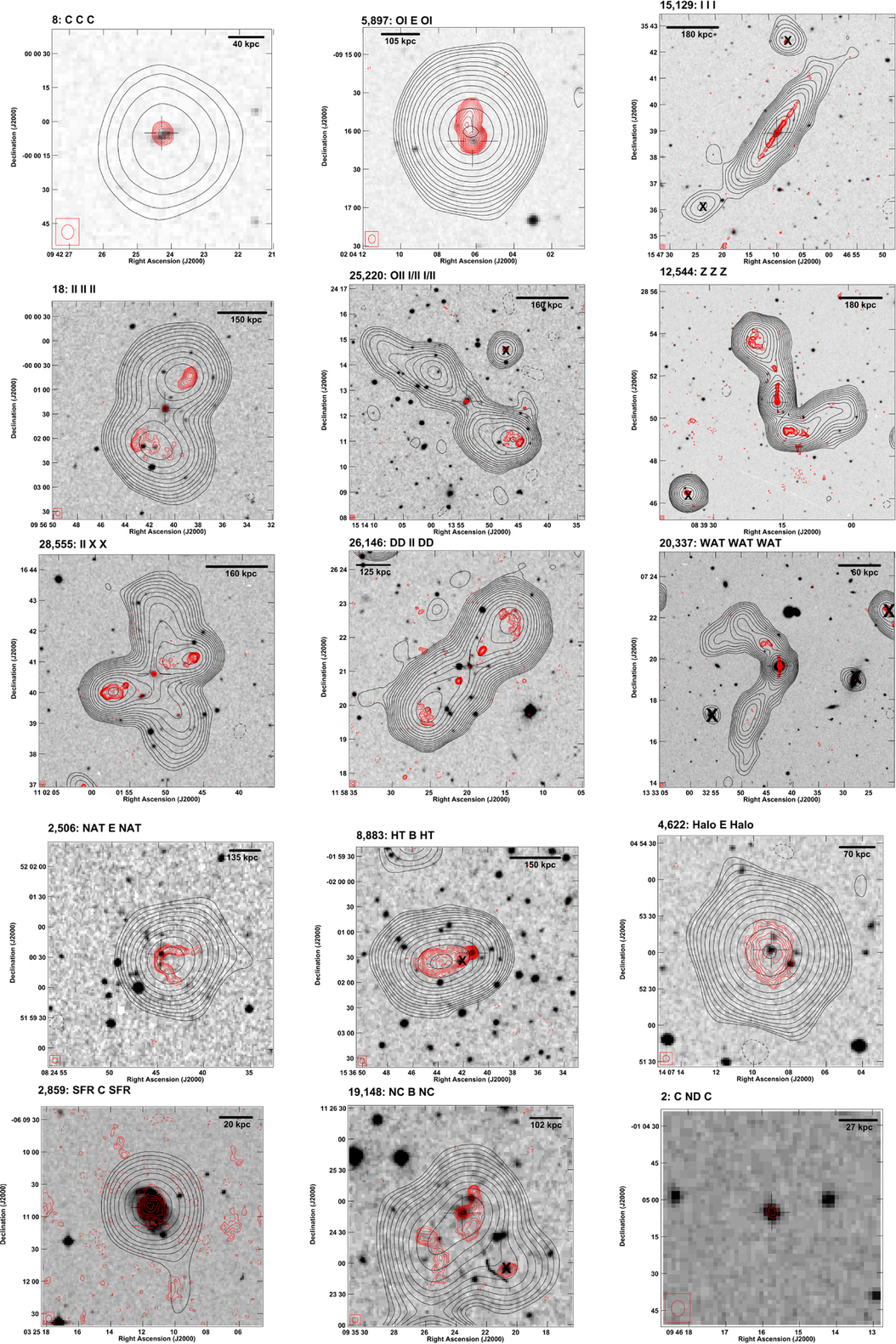Astronomy Object of the Month: 2021, December
< previous Archive next >
ROGUE I: a catalogue of Radio sources associated with Optical Galaxies and having Unresolved or Extended morphologies
How small and young radio sources evolve into large structures? Do all of them grow to large sizes? How the appearance of the radio source depends on the power of central nucleus, environment, and projection? How is the radio activity of active galactic nuclei (AGN) related to activity in other ranges of the electromagnetic spectrum? To answer all these and many other questions large catalogues of properly identified and classified radio sources are needed. Such information is now provided by the ROGUE I catalogue, produced and published by female researchers from the Astronomical Observatory of the Jagiellonian University.

Illustration 1:
The mosaic presenting examples of morphological types of radio sources highlighted in the Rouge
I catalogue. Credit: Kozieł-Wierzbowska i in.
In the era of high-sensitivity and high-resolution radio surveys, the classification of radio emission from extragalactic sources is not always an easy task. In this regard, some radio sources can be real rogues.
Radio emission from extragalactic radio sources can have many different shapes. In the map of a classical radio source a careful observer can distinguish a compact radio core, located at the position of the host galaxy, narrow jets terminating in hot spots and accompanied with the diffused radio lobes ( Faranoff-Riley type II), or spreading out in a form of plumes (Faranoff-Riley type I). However, radio sources with such classical morphologies represent only a fraction of the whole population. In some sources the jets start to bend at a small distance from the core forming a horseshoe-shape structure (wide-angle and narrow-angle tail sources). In others, we see two pairs of lobes inclined with respect to each other and forming an X-shaped structure. However, many times the radio structures have so complicated shapes that it is very difficult to say if they correspond to one source, or to two sources projected one on top of the other.
Nevertheless, not only a classification of the radio structure is important, but also an identification with its host galaxy in optical/IR images. Such an identification allows one to determine the distance and measure basic astrophysical parameters like luminosity or size.
The first part of the ROGUE catalogue produced by a team of researchers from the Astronomical Observatory of the Jagiellonian University contains radio sources identified with galaxies that have high quality spectra in the Sloan Digital Sky Survey (SDSS). The search was conducted using 1.4 GHz radio data obtained with different resolutions and sensitivities (NVSS and FIRST radio surveys). This enabled the proper recognition of both extended radio lobes, as well as the compact cores. For the 32,616 ROGUE I radio sources positions, magnitudes, redshifts, and morphologies of the optical host, as well as the morphologies and luminosities of the radio structure have been listed. This makes the ROGUE I catalogue the largest of its kind.
The statistics of the sources in the ROGUE I catalogue show that the majority of the radio sources detected in large surveys have compact morphologies (90%) and only a small fraction develop large radio structures. Among extended radio sources, classical morphologies are the most numerous (~50%), and a significant number of giant (size larger than 0.7 Mpc), X-shaped, Z-shaped, and double-double radio sources were discovered. The majority of the radio sources in ROGUE I catalogue have early-type, mainly elliptical host galaxies. In the catalogue star-forming (SF) galaxies are also present, and a method how to distinguish radio AGN from a radio SF is proposed in a separate paper (Kozieł-Wierzbowska et al. 2021).
Manual identification and classification is very laborious and time-consuming. For future catalogues based on deeper surveys (like LOFAR or SKA) such a work will not be possible, unless it becomes a citizen science project where thousands of persons participate. The ROGUE catalogue can serve as a training set for a citizen science project or for an automatic classification.
Original publication: Kozieł-Wierzbowska, D., Goyal, A. and Żywucka, N., Radio Sources Associated with Optical Galaxies and Having Unresolved or Extended Morphologies (ROGUE). I. A Catalog of SDSS Galaxies with FIRST Core Identifications, 2020, The Astrophysical Journal Supplement Series, 247, 28.
Project Website
The research was conducted at the Department of Stellar and Extragalactic Astronomy and Department of High Energy Astrophysics of the Jagiellonian University’s Astronomical Observatory (OAUJ). The work was financed by the NCN grants 2016/21/B/ST9/01620, 2018/29/B/ST9/02298 and DEC-2014/15/N/ST9/05171.
|
Dorota Kozieł-Wierzbowska Astronomical Observatory Jagiellonian University Eddie [at] oa.uj.edu.pl |
Natalia Żywucka-Hejzner Centre for Space Research North-West University N.Zywucka [at] oa.uj.edu.pl |


